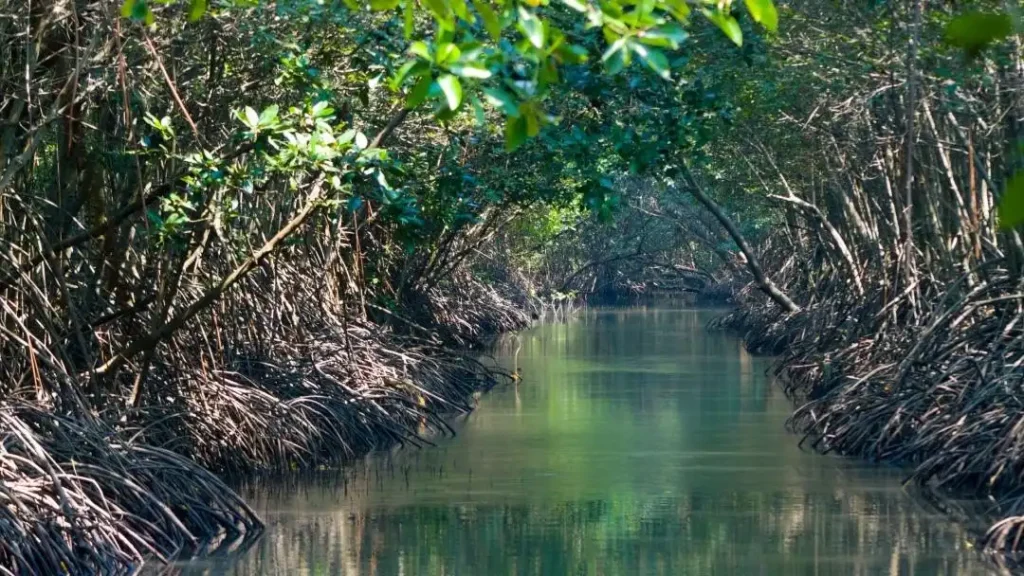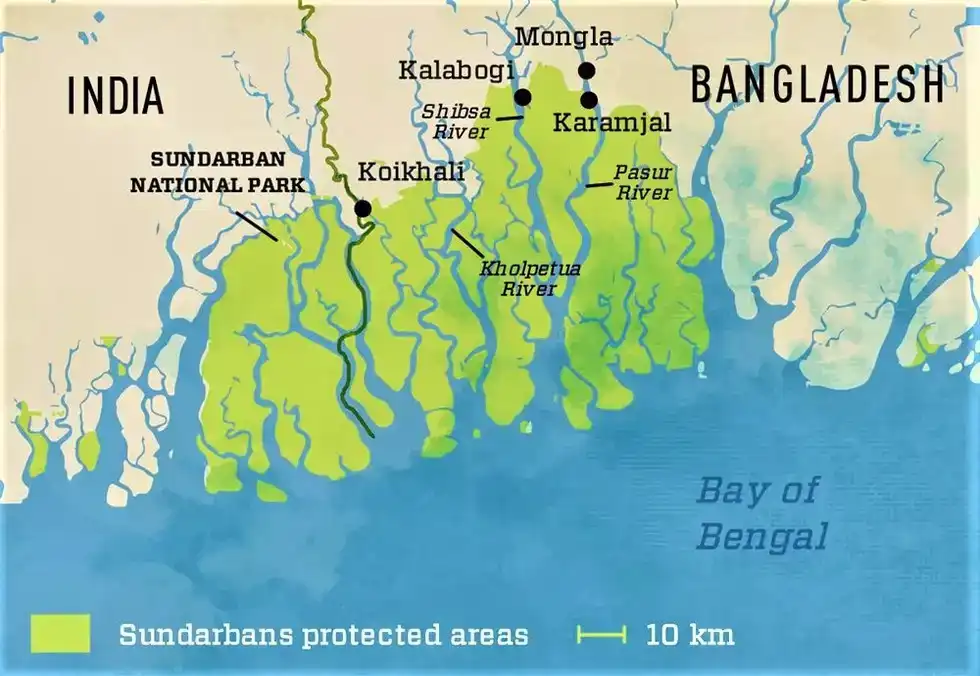Have you ever heard of a magical forest filled with tangled roots, water channels, and even swimming tigers? That place is the Sundarbans Mangrove Forest—a unique and fascinating part of our planet that has been declared a UNESCO World Heritage Site. But why is this forest so special?

Let’s dive into the world of the Sundarbans to discover what makes it worthy of such an honour.
Where are the Sundarbans?
The Sundarbans are the largest mangrove forest in the world. They stretch across the southern part of Bangladesh and the eastern part of India, mostly in the state of West Bengal.
The word Sundarbans comes from the Bengali words “Sundar” (meaning beautiful) and “ban” (meaning forest). So, it literally means “beautiful forest”!

This region is made up of hundreds of small islands, with many rivers, streams, and tidal creeks flowing through it. It lies in the delta of the Ganges, Brahmaputra, and Meghna rivers, right where they meet the Bay of Bengal.
What is a Mangrove Forest?
A mangrove forest is a special type found in coastal areas where salty sea water mixes with fresh river water. The trees in these forests are called mangroves. They have amazing stilt-like roots that grow above the ground to help them breathe even when the soil is underwater.

Mangroves protect the land from floods, storms, and erosion and are home to many unique animals and plants.
Why are the Sundarbans so important?
The Sundarbans are not just any forest—they are full of rare wildlife and amazing plants and play a huge role in protecting the environment.

Here’s why it is so special:
1. Home to the Royal Bengal Tiger
The Sundarbans is famous for being the home of the Royal Bengal Tiger. These majestic big cats are known for their unique ability to swim in salty water!

The Sundarbans have the largest population of tigers living in a mangrove forest. These tigers are strong, shy, and powerful hunters, and spotting one in the wild is a thrilling experience.
2. Incredible Biodiversity
The forest is home to:
- 260 species of birds
- Crocodiles, especially the giant saltwater kind
- Ganges and Irrawaddy dolphins
- Fishing cats
- Otters, monkeys, snakes, and even deer

And let’s not forget the unique plants that can survive in salty, muddy waters!
3. Natural Shield Against Storms
The Sundarbans act like a natural barrier. When cyclones or tsunamis hit the coast, the dense forest helps slow down the winds and waves, protecting the land and people from destruction. Without the Sundarbans, many coastal villages could face great danger.

4. Supports Local Communities
Over 4 million people live around the Sundarbans. Many of them depend on the forest for their daily lives. They catch fish, collect honey, harvest wood, and use plants for medicine. The forest gives them food, jobs, and safety.

Why did UNESCO declare it a World Heritage Site?
UNESCO (United Nations Educational, Scientific and Cultural Organisation) gives the title of World Heritage Site to places that are very special and important to the world.

The Sundarbans earned this title for two main reasons:
Criterion (ix): Outstanding Example of Natural Processes
The Sundarbans show how nature works in a delta—where rivers meet the sea. The forest changes with the tides, floods, and storms, creating a unique ecosystem that can’t be found elsewhere.

The mix of salt and freshwater, the shifting islands, and the mangrove trees are all part of this amazing natural process.

Criterion (x): Home to rare and threatened wildlife
UNESCO also chose the Sundarbans because it is home to rare and endangered species—like the Royal Bengal Tiger, estuarine crocodiles, and certain types of dolphins and turtles.

This forest is a biodiversity hotspot, meaning it has many different living creatures in one place. Many of these animals are not found anywhere else.
A Place for Science and Conservation
The Sundarbans are also a great place for scientists to study how nature works. Scientists learn how mangrove trees grow, how animals survive in salty water, and how to protect forests from climate change.
Many conservation programmes are working to:
- Protect the tigers and dolphins
- Plant new mangrove trees
- Teach people about saving the forest
Challenges the Sundarbans face
Even though it’s protected, the Sundarbans face some big problems:
Climate Change
Rising sea levels and stronger storms caused by climate change damage the forest. Saltwater is entering areas where it wasn’t before, harming trees and animals.

Human Activities
Some people cut down mangrove trees or hunt animals, which is dangerous for the forest. Pollution and too much fishing also affect the wildlife.

Human-Wildlife Conflict
Sometimes, tigers enter villages looking for food, leading to conflicts with people. Conservationists are working to find peaceful ways for humans and animals to live side by side.

Fun facts about the Sundarbans
- The Sundarbans cover about 10,000 square kilometres.
- It is the only mangrove forest where tigers live.
- The forest has many tidal rivers, which rise and fall with the moon.
- The area is also home to mudskippers—fish that can walk on land!

History of the Sundarbans
The Sundarbans has been known for centuries. People have lived near it since ancient times, using its resources to survive.
In 1987, the Indian part of the Sundarbans was declared a UNESCO World Heritage Site. The Bangladesh part joined the list in 1997.
This shows that both countries care deeply about protecting the forest and sharing its beauty with the world.

Why should kids care about the Sundarbans?
Even if you live far away from the Sundarbans, it still affects your life!
- It helps fight climate change by absorbing carbon dioxide.
It keeps our oceans healthy and clean.
It protects some of the rarest animals on Earth.
Most importantly, it teaches us how nature, animals, and humans can all live together.

You can help protect the Sundarbans by:
- Learning about wildlife
- Sharing what you know with friends
- Supporting eco-friendly activities
- Visiting responsibly if you ever travel there
Conclusion
The Sundarbans Mangrove Forest is truly one of Earth’s most amazing natural wonders. Its tangled roots, swimming tigers, chirping birds, and winding rivers create a magical world that’s like no other.
Being a UNESCO World Heritage Site helps protect this treasure, not just for today, but for the future.
For more interesting articles, please visit www.kidzherald.com




